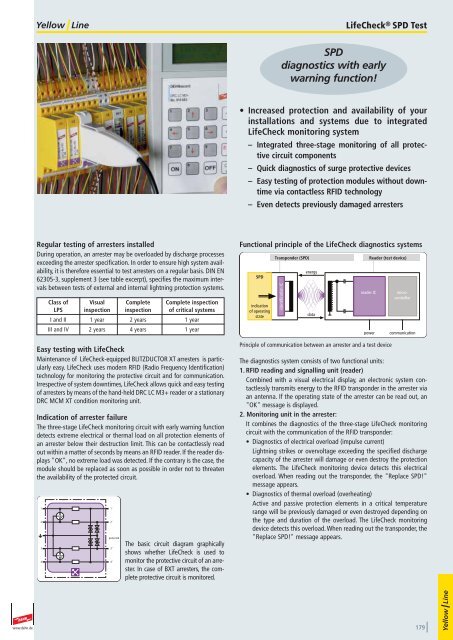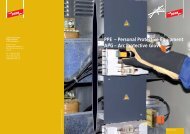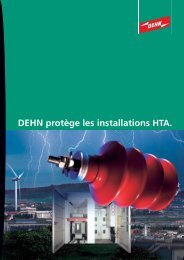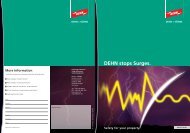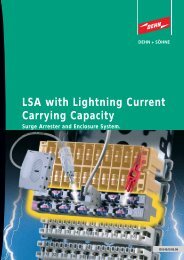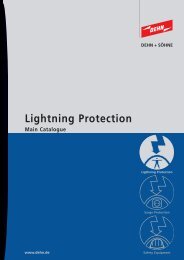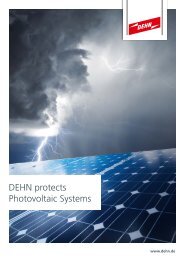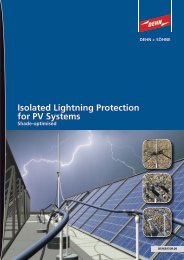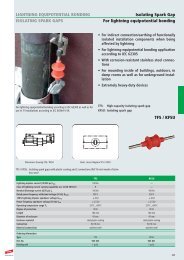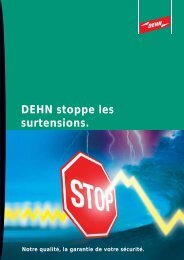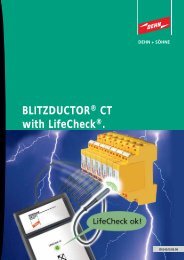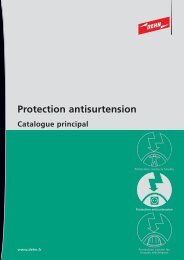Create successful ePaper yourself
Turn your PDF publications into a flip-book with our unique Google optimized e-Paper software.
LifeCheck ® SPD Test<br />
SPD<br />
diagnostics with early<br />
warning function!<br />
• Increased protection and availability of your<br />
installations and systems due to integrated<br />
LifeCheck monitoring system<br />
– Integrated three-stage monitoring of all protective<br />
circuit components<br />
– Quick diagnostics of surge protective devices<br />
– Easy testing of protection modules without downtime<br />
via contactless RFID technology<br />
– Even detects previously damaged arresters<br />
Regular testing of arresters installed<br />
During operation, an arrester may be overloaded by discharge processes<br />
exceeding the arrester specification. In order to ensure high system availability,<br />
it is therefore essential to test arresters on a regular basis. DIN EN<br />
62305-3, supplement 3 (see table excerpt), specifies the maximum intervals<br />
between tests of external and internal lightning protection systems.<br />
Class of Visual Complete Complete inspection<br />
LPS inspection inspection of critical systems<br />
I and II 1 year 2 years 1 year<br />
III and IV 2 years 4 years 1 year<br />
Easy testing with LifeCheck<br />
Maintenance of LifeCheck-equipped BLITZDUCTOR XT arresters is particularly<br />
easy. LifeCheck uses modern RFID (Radio Frequency Identification)<br />
technology for monitoring the protective circuit and for communication.<br />
Irrespective of system downtimes, LifeCheck allows quick and easy testing<br />
of arresters by means of the hand-held DRC LC M3+ reader or a stationary<br />
DRC MCM XT condition monitoring unit.<br />
Indication of arrester failure<br />
The three-stage LifeCheck monitoring circuit with early warning function<br />
detects extreme electrical or thermal load on all protection elements of<br />
an arrester below their destruction limit. This can be contactlessly read<br />
out within a matter of seconds by means an RFID reader. If the reader displays<br />
"OK", no extreme load was detected. If the contrary is the case, the<br />
module should be replaced as soon as possible in order not to threaten<br />
the availability of the protected circuit.<br />
1<br />
2<br />
3<br />
4<br />
1´<br />
2´<br />
protected<br />
3‘<br />
4‘<br />
The basic circuit diagram graphically<br />
shows whether LifeCheck is used to<br />
monitor the protective circuit of an arrester.<br />
In case of BXT arresters, the complete<br />
protective circuit is monitored.<br />
Functional principle of the LifeCheck diagnostics systems<br />
SPD<br />
indication<br />
of operating<br />
state<br />
Transponder (SPD)<br />
identification IC<br />
energy<br />
data<br />
reader IC<br />
Reader (test device)<br />
power<br />
Principle of communication between an arrester and a test device<br />
microcontroller<br />
communication<br />
The diagnostics system consists of two functional units:<br />
1. RFID reading and signalling unit (reader)<br />
Combined with a visual electrical display, an electronic system contactlessly<br />
transmits energy to the RFID transponder in the arrester via<br />
an antenna. If the operating state of the arrester can be read out, an<br />
"OK" message is displayed.<br />
2. Monitoring unit in the arrester:<br />
It combines the diagnostics of the three-stage LifeCheck monitoring<br />
circuit with the communication of the RFID transponder:<br />
• Diagnostics of electrical overload (impulse current)<br />
Lightning strikes or overvoltage exceeding the specified discharge<br />
capacity of the arrester will damage or even destroy the protection<br />
elements. The LifeCheck monitoring device detects this electrical<br />
overload. When reading out the transponder, the "Replace SPD!"<br />
message appears.<br />
• Diagnostics of thermal overload (overheating)<br />
Active and passive protection elements in a critical temperature<br />
range will be previously damaged or even destroyed depending on<br />
the type and duration of the overload. The LifeCheck monitoring<br />
device detects this overload. When reading out the transponder, the<br />
"Replace SPD!" message appears.<br />
www.dehn.de<br />
179


